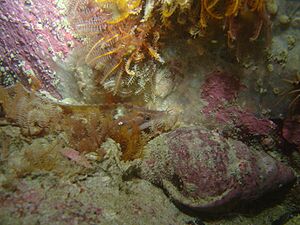Barbelled klipfish facts for kids
Quick facts for kids Barbelled klipfish |
|
|---|---|
 |
|
| Conservation status | |
| Scientific classification |
The barbelled klipfish (scientific name: Cirrhibarbis capensis) is a special type of fish. It's a species of clinid, which is a family of fish often found in rocky areas. This interesting fish lives in the warm, subtropical waters of the Atlantic Ocean near South Africa. It can grow to be about 36 centimeters (around 14 inches) long, which is about the length of a standard ruler. The barbelled klipfish loves to eat small crustaceans that live on the ocean floor, like tiny shrimp-like creatures called amphipods and isopods. It's currently the only known fish in its group, or genus.
Contents
What Does the Barbelled Klipfish Look Like?
The barbelled klipfish has a long, slightly flat body. Its head can be straight or a little curved, with a long, pointed nose. You can easily see small pores (tiny holes) on its head. It has a wide mouth with thick lips, and its lower jaw sticks out a bit more than its upper jaw.
Special Features: Barbels and Tentacles
One of the most unique things about this fish is its "barbels." These are like small, fleshy whiskers.
- It has three plain barbels at the front of its upper jaw. They are joined at the bottom but spread out.
- On its chin, it usually has eight barbels. Six of them are often in a circle, and two are a bit further back. These barbels help the fish feel and taste things in the water, helping it find food.
The barbelled klipfish also has interesting tentacles:
- Behind each eye, it has a short, flat tentacle that looks a bit like a hand with several fingers (4 to 12 cirri).
- At each front nostril, it has a large, flat tentacle with shallow, flat tips.
Fins and Body Details
The dorsal fin (the one on its back) is low and doesn't have a crest. The spines in this fin gradually get longer towards the tail. Each dorsal spine has a small cluster of 3 to 5 tiny cirri (small, finger-like projections) at its tip. Its pectoral fins (side fins) are rounded. The inner pelvic fins (fins on its belly) are very small.
Colors and Patterns
The barbelled klipfish can come in many different colors, which helps it blend in with its surroundings.
- Its main color is usually reddish, but it can be marbled with brown, green, or yellow.
- Often, it has a row of dark spots below its dorsal fin. It might also have irregular stripes or blotches on its body, sometimes with white speckles.
- The belly is usually a more solid color, either pale or dark.
- The tips of its anal, ventral, and pectoral fins are often red.
- Many of these fish have a roundish white spot with a black blotch behind their head, right where the lateral line (a sensory line along the side of the fish) begins.
- They can also be pinkish, gray, or greenish, sometimes with a milky look.
- Their fins and face whiskers are usually red.
- Younger fish and sometimes even adults can be milky white with black stripes along their body and red fins and face whiskers.
- Their eyes are dark with a thin reddish or yellow ring around the pupil.
- Very young fish (about 3-4 cm long) might have light and dark bands and can even be see-through! Young fish generally have much brighter colors than adults.
How Big Do They Get?
This fish can grow up to 35 centimeters (about 13.8 inches) long.
Where Does the Barbelled Klipfish Live?
This fish is special because it's only found in South Africa. It's not very common west of Cape Point, but you can find a lot of them from False Bay all the way to East London.
Specific Locations
They are seen most often in False Bay, in places like Fish Hoek, the wreck of the Clan Stuart, Windmill, and A-Frame. They are rarer on the Atlantic coast but have been spotted near the V&A Waterfront and along the Sea Point coast.
Depth and Young Fish
These fish are usually seen from close to the surface down to about 15 meters (around 50 feet) deep. Young barbelled klipfish are often found in very shallow water, sometimes just 1 meter (3 feet) deep or less, especially in the Knysna Heads area. Very young fish are found in shallow water, hiding under rocks and in rock pools.
What Kind of Home Does It Like?
Adult barbelled klipfish mostly live in deeper water, below the low tide mark. However, young fish are very common under stones in rock pools.
In deeper water, most adult fish are seen at night. They like to hide in areas with lots of shelter, like between and under large rocks. Younger fish are found in rock pools, where they can also find places to hide.
Why Is It Called "Capensis"?
The name "Capensis" comes from "Cape," which refers to the Cape region of South Africa. This is where the fish was first discovered and caught.


